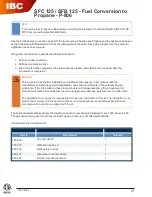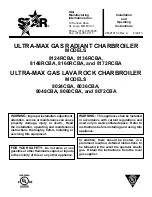
08/07/2008 4
BI301D
•
Boiler/Plumbing Kit Placement
– This model series is wall hung and the vessel must be vertical.
•
The plumbing kit items are located adjacent to the boiler housing itself as shown on drawing
BX3Ø1.
•
For future servicing, the unit itself must be installed a minimum of 18” (46 cm) above the
floor. The elements are screwed in from the bottom.
•
Allow adequate space for cover removal and maintenance.
•
Expansion Tank
- As a closed loop hydronic heating system, a minimal expansion tank is required.
This can be an air diaphragm tank as provided in the plumbing kit or a basic “empty” tank where air is
compressed at the tank top.
•
Temperature/Pressure Gauge
- Recommended to observe the operation of the system. Actually a
temperature gauge at the inlet and outlet is desirable.
•
Pressure Safety Valve
- This is required at the hot outlet and is furnished as a
loose
component with the
boiler unit itself. Failure to install the provided, 30 PSI (1.72 kPa), pressure relief valve as shown void
warranty and the CSA product listing.
Add the necessary pipe extension from the relief valve to the floor to prevent water damage on this unit
or surrounding area.
•
Gate Valve/Drain Valve
- These are for servicing and easy fill purposes.
•
Circulating Pump
- Depending upon system loop resistance (feet of head or kPa), the proper circulating
pump is required to guarantee the minimum GPM (L/min) flow as specified on the cover sheet.
Comment:
Circulator pump can be in the outlet or inlet. Newer, higher quality pumps seem to work
better in the supply line.
•
Air Vent Relief
- Whenever there is a plumbing point higher than any of the components shown or an
adjacent line (any vertical “U” trap), an air vent valve should be provided.
•
Building Water Supply Connection
– The intent of this connection is temporary and for fill purposes
only. The installer has the responsibility of complying with local building codes. Local codes may
require a backflow preventor when the domestic water supply line is fixed to the boiler mechanical
piping.
WATER ADDITIVES
1.
Unless the source water is unusually poor and/or rust elements, additives are not required. It is
recommended the water source as shown on drawing BX3Ø1 comes through the household water softener.
2.
Impurities within a closed loop hydronics boiler are considerably less damaging than the typical domestic
water heater. In a closed loop electric boiler, the water impurities “boil out” and the system essentially
reverts to pure water. As a closed system, this “pure water” becomes the operating mode. In the case of
domestic water tank, there is always new water entering with new impurities.
3.
However, if additives are required, use the recommendations and source from your local
professional plumber, specializing in hydronics heating systems.
WATER FILL PROCEDURE
This procedure applies to the prepackaged plumbing kit, referred to as EMB-BK, and/or when the system is
plumbed exactly as shown on drawing BX301, revision N. It is the installer’s responsibility to adhere to any local
plumbing codes.
Caution
: If the building supply pressure is connected directly to supply water ball valve without pressure
reducing regulator (reference drawing page 2 example), user needs to make sure the pressure within the boiler
loop does not exceed 30 PSI (206.8 kPa). Careful control of the supply water ball valve opening will take care
of this. Also at step 8 use caution to make sure the building water supply pressure does not “spike” the system.
1.
Connect drain hose to lower hose bib drain valve (open valve).
2.
Adapt water supply line to ¾” female iron pipe at the supply water ball valve.




































